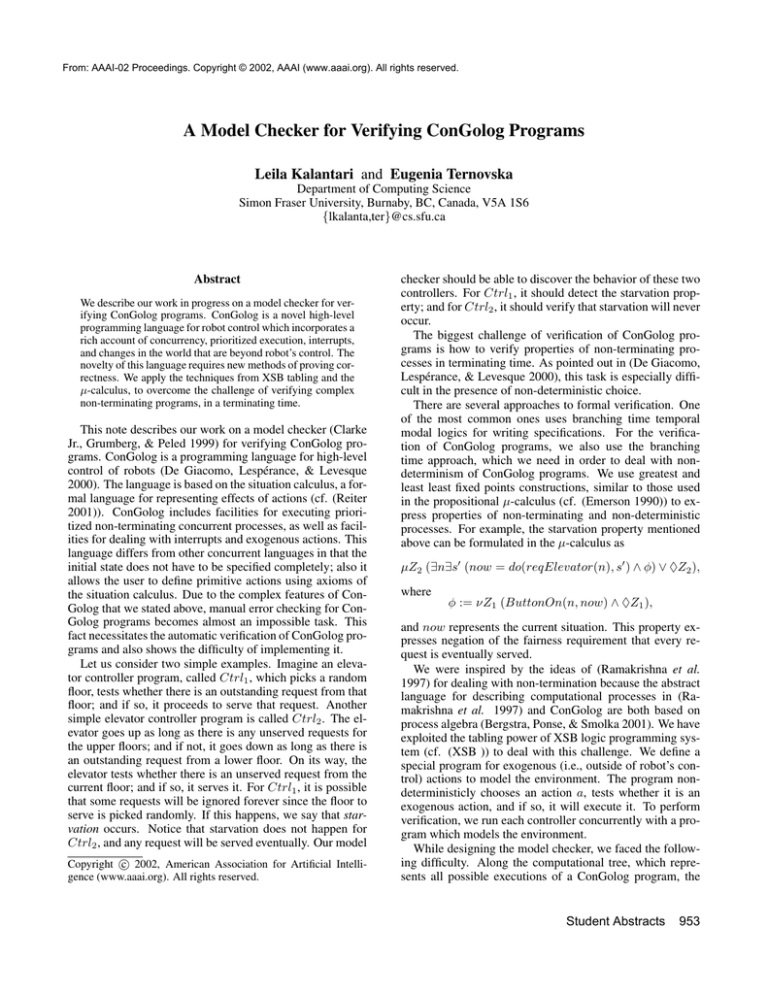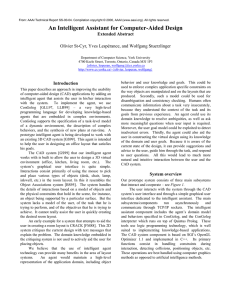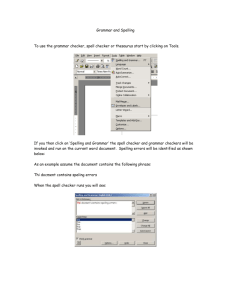
From: AAAI-02 Proceedings. Copyright © 2002, AAAI (www.aaai.org). All rights reserved.
A Model Checker for Verifying ConGolog Programs
Leila Kalantari and Eugenia Ternovska
Department of Computing Science
Simon Fraser University, Burnaby, BC, Canada, V5A 1S6
{lkalanta,ter}@cs.sfu.ca
Abstract
We describe our work in progress on a model checker for verifying ConGolog programs. ConGolog is a novel high-level
programming language for robot control which incorporates a
rich account of concurrency, prioritized execution, interrupts,
and changes in the world that are beyond robot’s control. The
novelty of this language requires new methods of proving correctness. We apply the techniques from XSB tabling and the
µ-calculus, to overcome the challenge of verifying complex
non-terminating programs, in a terminating time.
This note describes our work on a model checker (Clarke
Jr., Grumberg, & Peled 1999) for verifying ConGolog programs. ConGolog is a programming language for high-level
control of robots (De Giacomo, Lespérance, & Levesque
2000). The language is based on the situation calculus, a formal language for representing effects of actions (cf. (Reiter
2001)). ConGolog includes facilities for executing prioritized non-terminating concurrent processes, as well as facilities for dealing with interrupts and exogenous actions. This
language differs from other concurrent languages in that the
initial state does not have to be specified completely; also it
allows the user to define primitive actions using axioms of
the situation calculus. Due to the complex features of ConGolog that we stated above, manual error checking for ConGolog programs becomes almost an impossible task. This
fact necessitates the automatic verification of ConGolog programs and also shows the difficulty of implementing it.
Let us consider two simple examples. Imagine an elevator controller program, called Ctrl1 , which picks a random
floor, tests whether there is an outstanding request from that
floor; and if so, it proceeds to serve that request. Another
simple elevator controller program is called Ctrl2 . The elevator goes up as long as there is any unserved requests for
the upper floors; and if not, it goes down as long as there is
an outstanding request from a lower floor. On its way, the
elevator tests whether there is an unserved request from the
current floor; and if so, it serves it. For Ctrl1 , it is possible
that some requests will be ignored forever since the floor to
serve is picked randomly. If this happens, we say that starvation occurs. Notice that starvation does not happen for
Ctrl2 , and any request will be served eventually. Our model
c 2002, American Association for Artificial IntelliCopyright gence (www.aaai.org). All rights reserved.
checker should be able to discover the behavior of these two
controllers. For Ctrl1 , it should detect the starvation property; and for Ctrl2 , it should verify that starvation will never
occur.
The biggest challenge of verification of ConGolog programs is how to verify properties of non-terminating processes in terminating time. As pointed out in (De Giacomo,
Lespérance, & Levesque 2000), this task is especially difficult in the presence of non-deterministic choice.
There are several approaches to formal verification. One
of the most common ones uses branching time temporal
modal logics for writing specifications. For the verification of ConGolog programs, we also use the branching
time approach, which we need in order to deal with nondeterminism of ConGolog programs. We use greatest and
least least fixed points constructions, similar to those used
in the propositional µ-calculus (cf. (Emerson 1990)) to express properties of non-terminating and non-deterministic
processes. For example, the starvation property mentioned
above can be formulated in the µ-calculus as
µZ2 (∃n∃s (now = do(reqElevator(n), s ) ∧ φ) ∨ ♦Z2 ),
where
φ := νZ1 (ButtonOn(n, now) ∧ ♦Z1 ),
and now represents the current situation. This property expresses negation of the fairness requirement that every request is eventually served.
We were inspired by the ideas of (Ramakrishna et al.
1997) for dealing with non-termination because the abstract
language for describing computational processes in (Ramakrishna et al. 1997) and ConGolog are both based on
process algebra (Bergstra, Ponse, & Smolka 2001). We have
exploited the tabling power of XSB logic programming system (cf. (XSB )) to deal with this challenge. We define a
special program for exogenous (i.e., outside of robot’s control) actions to model the environment. The program nondeterministicly chooses an action a, tests whether it is an
exogenous action, and if so, it will execute it. To perform
verification, we run each controller concurrently with a program which models the environment.
While designing the model checker, we faced the following difficulty. Along the computational tree, which represents all possible executions of a ConGolog program, the
Student Abstracts
953
term representing the current situation grows and never repeats itself. This fact makes it difficult to use XSB tabling
to handle model checking for non-terminating programs.
Let us describe our approach to how to deal with this
problem. All possible executions of a non-terminating program compose an infinite computational tree. We observed
that, when trying to verify a property of a non-terminating
program, it is enough to verify that property for an initial
finite fragment of this tree. If the property holds in that fragment, we can conclude that it will hold for the whole infinite
computational tree. Our justification of this observation relies on a repetition pattern which occurs in the computational
tree — the state of the system, and the state of the program.
The first repetition factor is the repletion of the state of the
system along a computational path. Clearly, when the number of states is finite, the only way to obtain infinite computations is by looping through the transition system. So,
there must be at least one state that repeats itself. The second repetition factor is related to the execution of ConGolog
programs. There are two main constructs in the language
of ConGolog by which we can obtain infinite computations.
The first one is δ ∗ , which means that program δ is being repeated zero or more times. Clearly, after executing δ once,
what is left to execute is, again, δ ∗ . So, the program repeats itself at some point in the tree of situations. This fact
is reflected in the axiomatization of the predicates trans and
trans∗ (cf. (De Giacomo, Lespérance, & Levesque 2000)).
The same argument applies to the while construct, which is
evident from the same axiomatization.
Our model checker works on the computational tree by
using recursion on the subtrees. XSB tabling is used to terminate this recursion. When the same state of the system
and state of the program is encountered, instead of going on
with computation, XSB will make use of the results stored in
its table. This way, we verify properties of non-terminating
ConGolog programs in terminating time. At the moment,
our model checker is restricted to non-terminating programs.
At the time of writing this note, we have not completed
testing of the model checker on large programs. Occasionally, we obtain unexpected and contradictory results, and
some of them seem to coincide with the known bugs of
XSB system (Refer to the section “Restrictions and Current
Known Bugs” of “The XSB Programmers’ Manual”). We
are trying to obtain a better understanding of the XSB system to find the origin of the occasional misbehavior. As soon
as we get around these problems, we will proceed to prove
the correctness of our implementation. We will also study to
what extend we can eliminate any of our restrictions, most
notably, the requirement of finite number of fluents (i.e.,
properties of the world which change with performing actions).
Acknowledgments
The first author is grateful to Dr. David Warren and Luis
Fernando Pias de Castro for their help with the XSB system.
References
Bergstra, J.; Ponse, A.; and Smolka, S. 2001. Handbook of
Process Algebra. Elsevier Science.
954
Student Abstracts
Clarke Jr., E. M.; Grumberg, O.; and Peled, D. A. 1999.
Model Cheking. MIT Press.
De Giacomo, G.; Lespérance, Y.; and Levesque, H. 2000.
ConGolog, a concurrent programming language based on
the situation calculus. Artificial Intelligence 121:109–169.
Emerson, I. 1990. Temporal and modal logic. In van
Leeuwen, J., ed., Handbook of Theoretical Computer Science. 996–1072.
Ramakrishna, Y.; Ramakrishnan, C.; Ramakrishnan, I.;
Smolka, S.; Swift, T.; and Warren, D. S. 1997. Efficient
model checking using tabled resolution. In Proceedings of
the 9th International Conference on Computer-Aided Verification (CAV’97), Lecture Notes in Computer Science.
Haifa, Israel: Springer-Verlag.
Reiter, R. 2001. Knowledge in Action: Logical Foundations for Describing and Implementing Dynamical Systems. MIT Press.
The XSB, a logic programming system developed at
the State University of New York at Stony Brook.
http://xsb.sourceforge.net.






